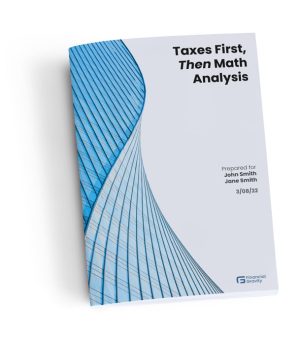We know the vast majority of New Year’s resolutions fail, and they often fail fast. About one-fourth fail in the first week of January. 80% of new gym memberships are canceled within five months. It’s a game we play with ourselves; after all, what’s so special about the new year?
Real change requires real change agency. Often, that comes in the form of a change in relationship status, or career, or location. Any financial advisor will tell you that when there’s marriage, or divorce, a new child, or a new job, people get focused on their financial lives.
Of course, they do. New research published just last September showed that the cost of raising a child from birth to 18 is now almost $240,000. Add to that the $104,108 for an average four-year degree (it can be over $233,000 for a private school). At a half million per kid, it’s no wonder that people think about money when a new bundle of joy appears.
It’s a very similar emotional state when you buy or sell a home, and particularly when you buy. The endless credit checks and forms and disclosures…it’s like a full-body exam for your finances. You have to dig out every statement and confront the reality of your security in retirement.
Recruiting Daily reports that only 6% of people change jobs for a higher salary or financial security. However, you still have to transfer your 401(k) or roll it over and make your benefit elections, including supplemental life insurance. You’re forced to consider long-term care and disability, two massive threats to your financial well-being.
Life changes like relationships, jobs, and location are pretty much in your face, but there is also something about the New Year. The Holidays are an emotional time, and they often involve complicated planning, complex relationships, and serious spending. It’s a physical/emotional/financial triple whammy that puts most people in a reflective mood about their entire life condition, not just the state of their finances.
In addition to the normal end-of-year considerations, we also have to concede that 2023 was, by most measures, a very trying year: inflation, rising interest rates, international conflict, and civil discord. On top of all that, The IRS has released tax brackets for the 2023 tax year that have upper limits 7% higher than the brackets for 2022 returns. That’s known as bracket creep, another effect of high inflation.
The Right Resolutions Make All The Difference
Putting all that together, it seems pretty likely that lots of folks will be making New Year’s resolutions in the coming weeks. Many of those resolutions will be about finances. If those resolutions will be looking to bring new discipline to retirement planning and preparation, we should approach things with optimism; after all, discipline is a choice, not a punishment. It doesn’t have to be an awful prospect. Quite the opposite, it can and should be a positive and life-affirming process—if we make resolutions that actually have a chance of success.
First, we should realize that we can’t do anything about inflation or any of the other downers from this year. But there’s a lot we can do to make 2024, and the years following, more positive by fixing the structural problems in financial accounts.
90+% of New Year’s resolutions fail because they are tactical in nature. They are not specific enough, they don’t require structural change, their time horizon is too vague, and there is no link to the things that truly matter. Will your life really change in any meaningful way if you lose 10 pounds? Will it matter if you gain them back in Spring?
The bigger problem with making financial resolutions is that the wrong resolutions are being made. A survey from November of 2022 found that those who make financial resolutions typically make tactical resolutions: pay off credit card debt, save for a new car or house, build an emergency fund, reduce spending, or invest more.
Tactical resolutions might be long the feel-good factor, but they could fail if they don’t address the more significant issues that keep your nest egg from compounding as it could. You can pay off debt and save more, but if your investments don’t grow after taxes, inflation, and fees, you won’t be getting much further ahead.
If you want to make changes that can actually change your life, consider these resolutions for 2024:
I will only work with true fiduciaries—professionals who are legally obligated to put my interests first.
I will have my CPA conduct a thorough analysis of my affairs to make sure I’m legally and ethically avoiding taxes on income, gains, and, possibly, my estate.
I will have an insurance fiduciary assess my risks, including disability and long-term care, and make sure my coverages match my risks.
I will implement an investing program I can stick with, no matter what the markets throw at me.
The problem with going to the gym is you have to keep going forever. If you lose the weight, you have to keep it off. But with the kind of resolutions suggested above, you can essentially set it and forget it. You’ll have changed the structure of your finances; you have arranged things so that compounding can work its magic.
Compound Interest: The Eighth Wonder Of The World
To fully realize the importance of tactical versus strategic resolution setting, let’s do a little experiment. Let’s say this is your status quo:
You earn 8% on average every year on your investment portfolio of $100.000. Sounds good. But your advisors and industry products cost you 3%, so you’re down to 5%. Half of your gains are in taxable accounts, which means 25% of your gains in those accounts go to federal and state governments. So now you’re down to 4%. Inflation could be expected to be 3%. So, your net gain is 1% per year. Your money will double every 72 years in real terms.
Tactical resolutions to pay down debt and save more could be a good thing. You make that resolution, follow through on it, and it allows you to invest an additional $5,000 per year. Growing at 1%, you’ll have a total account real, after inflation value of $232,114.
Now, let’s say you make strategic resolutions about your money. Let’s say you cut your costs in half to 1.5%, and you employ tax-forward investing and portfolio management strategies that reduce your taxes to just 5% of your gains per year. You now have a net gain of 3.3% per year and a real account value of $329,956 20 years later. That’s 42% more money.
There are key takeaways here. An obvious one is that inflation is a returns killer. Unfortunately, there is nothing you can do to change inflation; your only option is to stay invested and presume that the stocks you own will keep pace. But if you can cut your costs and improve your tax efficiency, which you can control, you can enjoy a very positive outcome.
One last piece of advice: before you make any resolutions, take careful stock of exactly where you are. Make the effort to learn what your real costs really are. Ask your CPA just how tax-efficient you are. Examine your portfolio to make sure you can live with the ups and downs that will surely come your way. When you know where you are and where you want to go, you have all the ingredients you need to make a successful journey possible.









